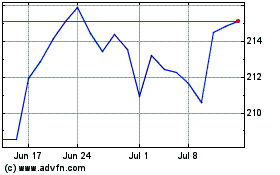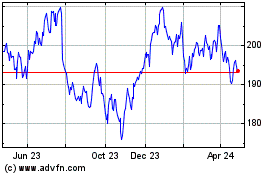GE Rides the Coattails of China's Global Dream
October 14 2016 - 9:16AM
Dow Jones News
By Brian Spegele
BEIJING-- General Electric Co. is targeting billions of dollars
in new sales in risky markets from Pakistan to Egypt as it and
other U.S. industrial giants seek to piggyback on Beijing's push to
open more markets to Chinese companies.
As China's economy slows and shifts away from the heavy industry
that long drove growth, multinationals are being driven to follow
China's state giants deep into the developing world. In the
process, many--including Honeywell International Inc. and Siemens
AG--are throwing their support behind China's bid to build roads,
ports and other infrastructure across a wide swath of
geography.
GE has been among the U.S. companies most aggressively seeking
to capitalize on President Xi Jinping's initiative, known as " One
Belt, One Road." By partnering with Chinese companies in emerging
markets, GE said, it can boost sales of its equipment such as
boilers for coal plants and wind turbines.
The aviation-to-health-care conglomerate thinks it can attract
annual orders of more than $5 billion in the coming decade in the
roughly 65 countries targeted under One Belt, One Road, said John
Rice, GE's vice chairman who leads global operations, That is more
than five times as much as in recent years in those countries. Much
of the growth will come from supplying power infrastructure in
underdeveloped markets, Mr. Rice said.
"We have to recognize that markets like China's have evolved,"
he said. The Chinese government is saying that "companies can't
just rely on the domestic market to be successful. They have to go
global."
Take Pakistan, one market that has been aggressively targeted by
Chinese engineering companies and GE. Beijing has committed to
spending at least $35 billion on financing and building power
plants in Pakistan by 2030. GE said its orders in the country have
risen to more than $1 billion today compared with less than $100
million five years ago.
The company is joining other U.S. and global industrial giants
saying they are eager to do more business with Chinese companies as
they go global. Top executives at heavy-machinery maker Caterpillar
Inc., shipping giant A.P. Møller-Mærsk A/S and others have also
publicly supported the One Belt, One Road plan.
"Everybody is figuring out that this is a serious effort," Mr.
Rice said. "It is going to happen with us or without us."
GE executives say the company is already supplying Chinese firms
with natural-gas turbines in Pakistan and Bangladesh, wind turbines
in Kenya, and hydropower equipment in Laos, among other deals.
GE has done business in China in one form or another for more
than a century, setting up a lightbulb factory in the northern city
of Shenyang as early as 1908. It employs around 22,000 people in
China, though its revenue was near flat last year, compared with
double-digit growth in recent years, reflecting China's
slowdown.
Underlining its support for China's global expansion, GE hosted
on Friday nearly 1,000 industry players at a lavish compound the
Chinese government frequently uses to receive foreign dignitaries.
A former Chinese vice foreign minister was in attendance.
For China's companies, the international ambition is born out of
necessity. Left with vast oversupply of everything from steel to
advanced industrial parts as the economy slows, they must look for
growth outside China's borders.
The push comes with massive challenges, including a shortfall of
financing for infrastructure in frontier markets. Even the launch
of the Beijing-backed Asian Infrastructure Investment Bank, which
has been called China's answer to the World Bank, hasn't been
enough to close the gap, Mr. Rice said.
Yet, seeking out new business across frontier markets will be
key for GE's growth, analysts said. The company's power segment is
already one of its biggest business lines, and increasing revenue
will be tough in developed markets such as the U.S.
"All the new capacity is happening in the fast-growth markets,"
said Deane Dray, an analyst at RBC Capital Markets, which said it
has done business with GE in the past year. "And that's where GE is
focused."
Saeed Shah in Islamabad, Pakistan, contributed to this
article.
Write to Brian Spegele at brian.spegele@wsj.com
(END) Dow Jones Newswires
October 14, 2016 09:01 ET (13:01 GMT)
Copyright (c) 2016 Dow Jones & Company, Inc.
Honeywell (NASDAQ:HON)
Historical Stock Chart
From Mar 2024 to Apr 2024

Honeywell (NASDAQ:HON)
Historical Stock Chart
From Apr 2023 to Apr 2024
